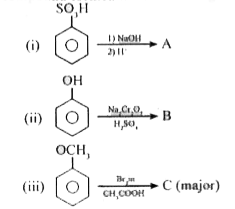Complete Solutions to PART - D of chapter II PUC CHEMISTRY (P.U. BOARD LATEST MODEL QUESTION PAPER - 2) of Class 12 book with complete answers and questions
| Class 12 | CHEMISTRY |
| Chapter | II PUC CHEMISTRY (P.U. BOARD LATEST MODEL QUESTION PAPER - 2) |
| SUNSTAR PUBLICATION | PART - D |
| Number Of Questions | 28 |
| Academic Year | 2023-24 |
Caleulate the packing efficiency in a unit cell of Cubic Close Packing(CCP) structure.
04:47View SolutionExplain with an example how impurity defect develops in `NaCl` crystal.
04:51View SolutionCalculate the mole fraction of Co, in one litre of soda water sealed under a pressure of `"3.5 bar at 298 K". K_(H)=1.67xx10^(3)" bar"`
02:08View SolutionWhat are these?
i) solid solutions ii) colligative properties iii) isotonic solution04:31View Solutiona) i) Name the product liberated at anode when dil. `H_(2)SO_(4)` is electrolysed.
02:35View Solutionii) What Faraday of current is required to electrolyse one mole of water?
01:40View Solutionb) i) Between mercury cell and nickel-cadmium cell, which is a secondary cell?
02:31View SolutionMention one advantage of `H_(2) - O_(2)` fuel cell.
01:50View Solutionc) Write Nernst equation for the cell represented as: `Mg(s)|Mg_((aq))^(+2)||Al_((aq))^(3+)|Al_((S))`.
04:43View SolutionShow that for a first order reaction, `t_(99.9%)=10t_(1//2)`.
05:20View Solutionb) In the graph drawn what does A and the shaded region B represent?
 View Solution
View SolutionName the phenomenon/process involved
i) mixing of hydrated ferric oxide (`+ve` sol) and arsenious sulphide (`-ve` sol)
ii) An impure sol is purified by removing dissolved particles using suitable membrane
iii) Movement of dispersion medium is observed in an electric field.02:10View SolutionMention any two characteristic of enzyme catalysis.
02:05View Solutiona) Write the equation for `SN^(2)` mechanism between `CH_(3)Cl and -OH`. What is the stereochemical aspect of `SN^(2)` reaction?
04:50View Solutionb i) Aryl halide with sodium in dry ether undergoes Fitting reaction. Write the equation and name the product.
ii) Arrange the following in the increasing order of their reactivity towards nuclelophilic substitution reaction.
 05:29View Solution
05:29View Solutiona) What is the organic compound formed in the following :
 03:48View Solution
03:48View Solutionb) Give reason: -
i) o-nitrophenol and p-nitrophenol can be separated by steam distillation.
ii) There is a large difference in boiling points of alcohols and ethers.05:59View Solutiona) Write the structure of P and Q? Name the reaction that gives the product P.
 04:02View Solution
04:02View SolutionExplain decarboxylation reaction with an example.
02:30View Solutiona) Name the products X and Y?
 01:53View Solution
01:53View Solutionb) Between methyl amine and ammonia which has lower `pK_(b)` value and why?
03:11View SolutionName the final product of ammonolysis of an alkyl halide.
02:29View SolutionDraw the Haworth structure of `beta`-(D) fructofuranose.
01:49View Solutionb) i) Pentaacetate of glucose does not react with hydroxyl amine. What does this indicate about the structure of glucose.
ii) Which is the most abundant polysaccharide in plants?
iii) Name the natural a-amino acid that is not optically active.07:48View SolutionWhat major molecular shape does the tertiary structure of protein lead to?
03:13View SolutionWhat is a homopolymer? Give an example.
01:39View SolutionWrite the equation for the formation of the polymer by the interaction of ethylene glycol and terephthalic acid. Name the polymer.
02:11View Solutionc) Molecular mass of polymers are expressed as an average. Give reason
04:42View Solution
PART - D questions and complete solutions for chapter II PUC CHEMISTRY (P.U. BOARD LATEST MODEL QUESTION PAPER - 2) of SUNSTAR CHEMISTRY (KANNADA ENGLISH) of Class 12
